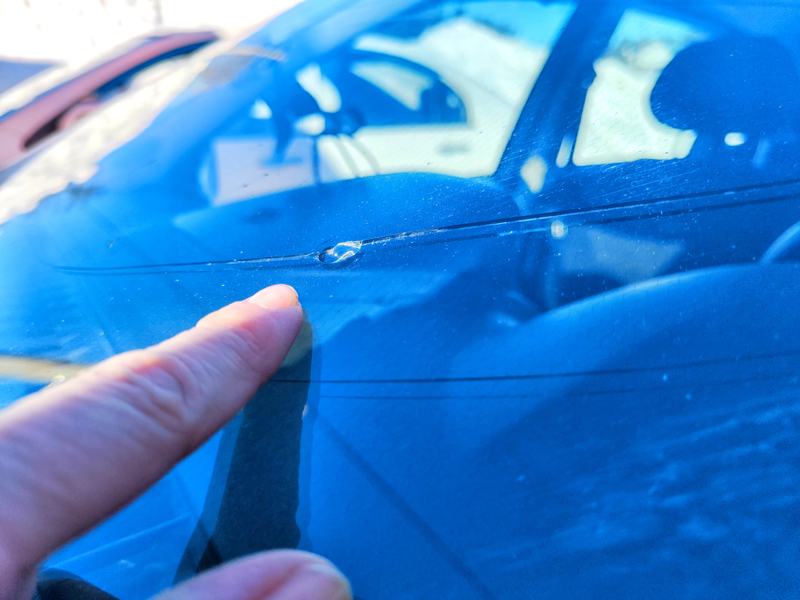Key Takeaways
- Windshield chips from hail are often overlooked but can compromise safety and quickly spread into full cracks—especially in the summer heat.
- Summer temperatures accelerate chip expansion, as glass layers heat and cool at different rates, increasing the risk of further damage.
- Hail chips and rock chips may look similar, but hail damage typically occurs while stationary and is more surface-level—yet still demands quick attention.
- Untreated chips can fail vehicle inspections and cost more to fix later, turning a simple repair into a full windshield replacement.
- US Hail Repair offers complete post-storm services, including Paintless Dent Repair and windshield repair/replacement across its Texas partner network, simplifying your recovery after a hailstorm.
When most people think about hail damage, their minds immediately go to dented hoods, roofs, and trunks. But there’s one area that often gets overlooked until it’s too late: the windshield. That seemingly small chip from a recent storm might not look like much now, but it can quickly turn into a major crack, especially with summer’s intense heat.
The Overlooked Casualty of Hail: Your Windshield
Hailstorms can be powerful enough to dent metal and crack plastic, so it’s no surprise they can also impact your vehicle’s glass. While body dents are easy to spot, windshield damage is often subtle small ding, a faint chip, or a hairline crack. Many drivers don’t realize their windshield was damaged until weeks later, when the chip spreads suddenly in the summer heat.
Even minor chips weaken the structural integrity of your windshield, which plays a key role in passenger safety. According to the National Highway Traffic Safety Administration (NHTSA), your windshield supports up to 45% of the vehicle’s structural integrity in a front-end collision and up to 60% in a rollover. That’s why timely repair or replacement is crucial.
Why Chips Spread Faster in the Summer
Temperature plays a major role in the health of your auto glass. When your vehicle sits in the hot sun, the outer layer of the windshield heats up while the inner layer stays relatively cool. This difference in temperature causes the glass to expand and contract at different rates—a recipe for spreading cracks.
Even a chip caused by hail, which might look like a rock chip at first glance, can spread across the windshield in just a few hot afternoons. Combine that with driving on rough roads, slamming doors, or hitting potholes, and that minor damage becomes a major problem quickly.
Rock Chip vs. Hail Chip—Is There a Difference?
Technically, yes. A “rock chip” refers to damage caused by a small object—usually a stone—hitting the glass at high speed, typically while driving. These chips often look like bullseyes, stars, or tiny craters.
Hail chips, on the other hand, are caused by ice pellets hitting the windshield, often while the vehicle is stationary or moving slowly. These can appear similar to rock chips, but they tend to be shallower and can sometimes create small surface cracks or spidering patterns.
The key difference is the context. If your car was caught in a hailstorm and you noticed a chip afterward, odds are it wasn’t caused by road debris—it was hail. Either way, the repair process is similar, and early detection is critical.
Why Glass Damage Deserves the Same Attention as Body Damage
Auto glass repair often gets deprioritized after a storm. Drivers may address large dents or insurance claims for body damage first, leaving chips in their windshield as an afterthought. But untreated glass damage poses both immediate and long-term risks:
- Compromised safety: As mentioned earlier, your windshield is crucial for structural support.
- Failed inspections: Many states won’t pass a vehicle with visible windshield damage during safety inspections.
- Higher repair costs: A small chip can often be repaired inexpensively. If left untreated, it can require full windshield replacement—costing several hundred dollars or more.
What to Do If You Spot a Chip After a Storm
- Inspect thoroughly: After a hailstorm, take time to inspect your vehicle in daylight, including the windshield, side windows, and mirrors.
- Take photos: Document any damage before driving further, especially if you plan to file an insurance claim.
- Cover it if needed: If the chip is open or has begun cracking, placing a small piece of clear tape over it can temporarily protect it from debris or moisture.
- Schedule a repair ASAP: Many auto body shops that offer hail repair also provide glass services or partner with nearby specialists.
Glass Repair: A Natural Extension of Hail Repair Services
While most people associate hail repair with Paintless Dent Repair (PDR), glass services are often included in comprehensive storm recovery. That’s why many of the locations in the US Hail Repair partner network offer or coordinate windshield repair and replacement as part of the hail repair process.
It’s convenient, fast, and helps ensure your entire vehicle is restored—both structurally and cosmetically.
Don’t Wait—A Chip Is Only the Beginning
Hailstorms might be short-lived, but their impact can linger long after the skies clear. That tiny chip in your windshield—barely noticeable at first—can quickly turn into a sprawling crack that puts your safety, your wallet, and your time at risk. Waiting too long to address glass damage can escalate what would’ve been a quick repair into a full replacement, often at a much higher cost.
The best defense? Act fast.
If your vehicle has been through a recent hailstorm, take a few minutes to inspect your windshield and windows. Don’t assume it’s “just a chip” or that it can wait. Glass damage is one of the easiest things to fix early—and one of the most expensive problems to ignore.
One-Stop Hail Repair: Dents, Dings, and Damaged Glass
Whether your car took a beating from hailstones or just suffered a few minor dings, US Hail Repair’s network of trusted repair locations across Texas is equipped to handle it all—from Paintless Dent Repair (PDR) to professional windshield inspection and replacement. You don’t need to bounce between shops or coordinate multiple appointments—we’ve streamlined the process to make your hail recovery hassle-free.
Restore More Than Just Your Vehicle’s Appearance
Think of it this way: repairing your windshield isn’t just about making your vehicle look good. It’s about restoring the safety features that protect you and your passengers every time you get behind the wheel. Modern windshields are engineered to work in tandem with airbags, prevent roof crushes in rollovers, and maintain overall vehicle stability. That small chip? It’s compromising much more than your view of the road.
Caught in a Texas hailstorm? Don’t wait for that chip to turn into a crack. Find your nearest repair location and get your windshield—and the rest of your vehicle—back in shape today.



